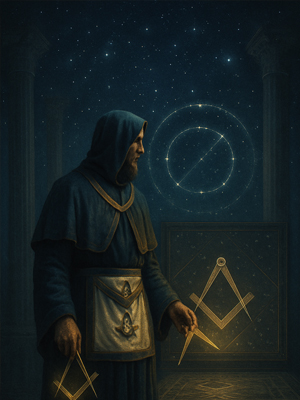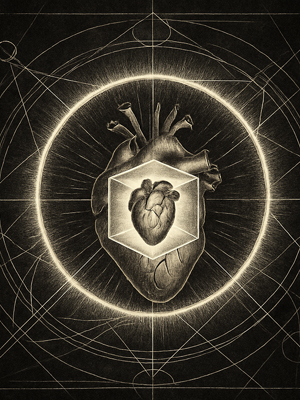Masonic Articles and Essays
The Mystery of the Circle and Square
Exc... Bro... Aksel Suvari 18°
Date Published:
11/13/2025
Could an ancient, intractable problem of geometry and mathematics hold the mystic key to awakening human consciousness?
 In the hidden architecture of the Mysteries, where number and form are not mere abstractions but revelations of divine truth, geometry becomes a language of the gods. Each figure is a word, each proportion a sentence, and the initiate who learns to read them perceives the eternal dialogue between spirit and matter. Among these sacred forms, none has provoked deeper contemplation or been more richly invested with symbolic power than the Circle and the Square. Their relation, expressed in the ancient enigma of squaring the circle, stands as one of the highest allegories of the initiatic path, representing nothing less than the reconciliation of the finite with the infinite, of man with God, of the earthly temple with the heavenly archetype.
In the hidden architecture of the Mysteries, where number and form are not mere abstractions but revelations of divine truth, geometry becomes a language of the gods. Each figure is a word, each proportion a sentence, and the initiate who learns to read them perceives the eternal dialogue between spirit and matter. Among these sacred forms, none has provoked deeper contemplation or been more richly invested with symbolic power than the Circle and the Square. Their relation, expressed in the ancient enigma of squaring the circle, stands as one of the highest allegories of the initiatic path, representing nothing less than the reconciliation of the finite with the infinite, of man with God, of the earthly temple with the heavenly archetype.
The Circle, first among figures, is the sign of unity and eternity. It is without beginning or end, without edge or boundary, and thus mirrors the unconditioned essence of the Divine. It encompasses all and is encompassed by none. In its perfect curvature, no angle disturbs its continuity, no point prefers itself above another. It is therefore the image of the Infinite, the Monad, the boundless source from which all proceeds and to which all returns. To the initiate, the Circle is the visible expression of the invisible, the outline of the eternal mystery, the emblem of that omnipresent Spirit in whom all being lives, moves, and has its existence.
The Square, on the other hand, is the form of the finite. It is stability, order, limitation, and definition. Its right angles symbolize rectitude, justice, and the moral law. It is the figure of the Earth, divided into the four quarters, governed by the four elements, and sustained by the four cardinal virtues. If the Circle speaks of the heavens, the Square speaks of the world; if the Circle represents the unmanifested, the Square represents manifestation. The two are thus complementary and opposed, heaven and earth, spirit and matter, eternity and time, perfection and progress.
To square the circle is therefore to find that measure by which these two apparent opposites are brought into harmony. It is to reconcile the divine with the human, to bring the celestial order into correspondence with the terrestrial, and to make the soul itself a temple in which heaven and earth are conjoined. The ancient philosophers and adepts, who clothed the highest truths in the veil of geometry, understood this not as a problem of mathematics but as an allegory of regeneration. For in the visible world, the circle and square can never be made exactly equal; their union defies the calculations of reason. Yet within the inner world of the spirit, the reconciliation is achieved when the human being, disciplined by virtue and illuminated by wisdom, becomes the living reflection of the eternal law.
In the discipline of initiation, every line and angle of these two figures becomes a step in the ascent from ignorance to illumination. The initiate, entering the Lodge of life, finds himself at first as the Rough Ashlar, a stone taken from the quarry of the world, unshaped and imperfect. His task is to cut, polish, and proportion this stone according to the measure of the Square, which signifies moral law and upright conduct. To live squarely is to bring the errant forces of desire, fear, and pride into balance, to make the foundation of life just and true. The Square teaches him that no spiritual edifice can rise without the exactness of ethical order.
But when the foundation is firm, a higher labor begins. The Mason must now learn the art of the Compass, which inscribes the Circle, symbol of the divine principle that surrounds and vivifies the moral structure. The Compass measures not only the breadth of the heavens but the range of the soul’s aspiration. As the Square governs action, the Compass governs intention; as the Square relates to the outer world, the Compass relates to the inner; as the one regulates conduct, the other sanctifies purpose. The perfect Mason, therefore, is he in whom the Compass and the Square are united in due proportion, whose life is both righteous and inspired, both ordered and illumined.
The attempt to square the circle in geometry mirrors this spiritual aspiration. The mathematician may multiply his calculations to infinity and never reach a final measure, for the infinite cannot be contained in number. The initiate, however, perceives that this impossibility is itself the revelation. It shows that reason alone can never bridge the gulf between the finite and the infinite. The path of equilibrium lies not in calculation but in transformation. Only when man himself becomes the mediator between heaven and earth, when his own nature reflects the harmony of the cosmos, does the circle descend into the square and the square ascend into the circle.
In this sense, the operation of squaring the circle is the true work of initiation, the Great Work of the inner alchemist. The circle represents the spiritual essence, the divine spark within the soul; the square represents the lower nature, bound to the material world. To square the circle is to draw the infinite into the finite, to incarnate the divine within the human without corrupting its purity. It is to make matter the servant of spirit, form the vessel of light, and personality the instrument of the universal will. In this transformation, the lower nature is not destroyed but redeemed; it becomes the cube, the perfected stone of the Temple, stable upon its base yet radiant with celestial order.
 The cube itself is the visible completion of this mystery. It possesses six equal faces, twelve edges, and eight points, numbers that conceal within them the keys to cosmic proportion. It is the perfect balance of the vertical and horizontal, of the forces that ascend and those that sustain. In it, the initiate recognizes the perfected man, whose intellect, will, and heart are harmonized, and whose every action reflects the geometry of divine reason. The cube is the squared circle made manifest, the microcosm reflecting the macrocosm, the image of God realized in man.
The cube itself is the visible completion of this mystery. It possesses six equal faces, twelve edges, and eight points, numbers that conceal within them the keys to cosmic proportion. It is the perfect balance of the vertical and horizontal, of the forces that ascend and those that sustain. In it, the initiate recognizes the perfected man, whose intellect, will, and heart are harmonized, and whose every action reflects the geometry of divine reason. The cube is the squared circle made manifest, the microcosm reflecting the macrocosm, the image of God realized in man.
This sacred geometry reveals the eternal law of correspondence, that spirit seeks embodiment, and matter seeks sanctification. The universe itself is the circle squared by the Great Architect, the infinite made visible through the harmonies of form, number, and motion. Creation is the ongoing act by which the circle limits itself to produce the square, and redemption is the process by which the square returns toward the circle. The two operations are one, for creation and redemption are not opposites but phases of the same eternal rhythm, the breathing of the Divine within the fields of time.
Thus the Mason, tracing the figures of his art upon the trestleboard of meditation, comes to perceive that his tools are symbols of cosmic law. The Compass and Square, the rule and the level, the plumb and the gavel, are not mere instruments of architecture but hieroglyphs of the soul’s own labor. To use them rightly is to participate in the creative act of the Logos, to build within oneself that inner temple whose proportions mirror the harmony of heaven. The work is long and exacting, for every line must be true and every angle just, but when the task is complete, the temple stands as a reflection of the divine order, a geometry of living light.
When the circle is squared within the soul, the initiate stands at the center of all worlds. The heavens reflect upon the floor of earth, and the earth ascends into the radiance of heaven. Time no longer binds him, nor space divides him, for he has found the proportion that unites all opposites. He becomes, in his degree, a living cornerstone of the cosmic temple, finite in form yet infinite in essence, a mirror of the Architect who traced both compass and square upon the face of the deep.
To square the circle is, in truth, to complete creation within oneself. It is to make of the heart a sanctuary where the eternal dwells in the temporal, and of life a ritual of harmony between will and law, wisdom and love, spirit and flesh. It is the consummation of the Masonic art, the end toward which every degree points and every symbol leads. And when that art is fulfilled, when the inward architecture stands complete, the initiate beholds the secret of the ages written in his own being: that the circle was never apart from the square, nor the square from the circle, but both are one in the eternal plan of the Great Geometer, whose compass is Love and whose square is Law, and whose Word is the harmony of all things made manifest in Light.
More Masonic Articles
Explore articles and essays written by Freemasons about Freemasonry.
Read More
Membership
Interested in becoming a member of the worlds oldest Fraternal organization?
Read More